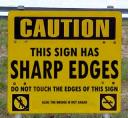Not so much a chemical information post today as a diatribe against natural terminology used by the countless chemophobes out there.
I had a query this morning from a reader asking whether adding bleach to the water used with their cut, fresh flowers would reduce fungal infections and so somehow prolong their bloom time. I suspect there’s probably a drop of truth in the idea, but in trying to find a definitive answer I found a gardening type page that discussed the issue.
In it, the author of the item, Marion Owen (whom I am sure is a lovely person) asserts that, “If you don’t like to use chemicals to prolong the life of your cut flowers, there are “natural” alternatives.” She then goes on to list various chemicals that one might add – a penny, aspirin, lemon-lime soda, bleach, lemon juice, sugar, bleach, and listerine. At this point, I’m not worried about whether my blooms stay blooming lovely or not, but am taken aback by how she seems to be defining the word chemical. She’s not alone, of course, millions of people make similar assertions about detox diets that avoid chemicals (so, what do you eat when you’re on a detox diet, raw energy?)
Anything Marion and her readers might add to a vase of flowers is made from chemicals. The flowers themselves are made from chemicals (proteins, carbohydrates, fats, water, minerals etc), lemon juice (water, citric acid etc). Even the water itself (dihydrogen monoxide)!
But, more to the point it’s that use of the word “natural” with which I take umbrage, natural usually preserved for non-synthetic chemicals (although there is no actual distinction in nature between natural and synthetic, humans are “natural” after all). Maybe she meant to specific agrichemicals or chemicals produced by the industry for the specific purpose of reducing mould and extending bloom life. Wouldn’t you rather use something designed specifically for the job rather than adding a random selection of household chemicals to the vase. What, if the bleach and that carbonated lemon-lime drink react, catalysed by the copper penny, to produce some noxious vapour? At best, the flowers would more likely fade faster, but you might also get a nasty whiff of something when you lean over to catch their scent!
Anyway, how can adding aspirin be considered a natural alternative to adding chemicals? Of course, you might use sap from the cricket bat willow (Salix alba) which contains salicylic acid, the active metabolite of aspirin, but that would still be adding chemicals to the flowers, natural or not, and the very process of extracting the sap, is that natural?
Of course, the whole activity of cultivating blooms, hacking them from their plant and sticking them in a vase and leaving them to die with no chance of producing offspring is in itself not an entirely natural thing to do. But, how do you segregate anything humans do from the natural world in the first place? Human intellect and activities are as much a part of the natural world as the very flowers we admire, the insects that would normally pollinate them, the moulds and microbes that grow on them and apparently shorten the blooming lives, the insects and fungi that will rot them on our compost heaps, and the soil bacteria that will feed on them producing the right conditions for next year’s flowers.






